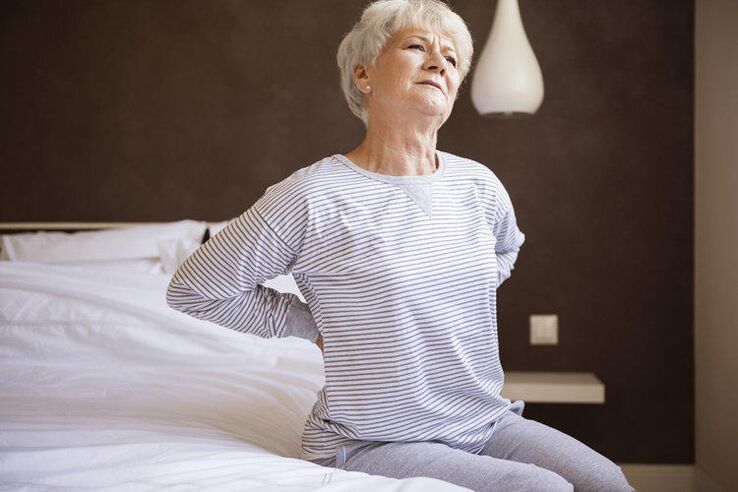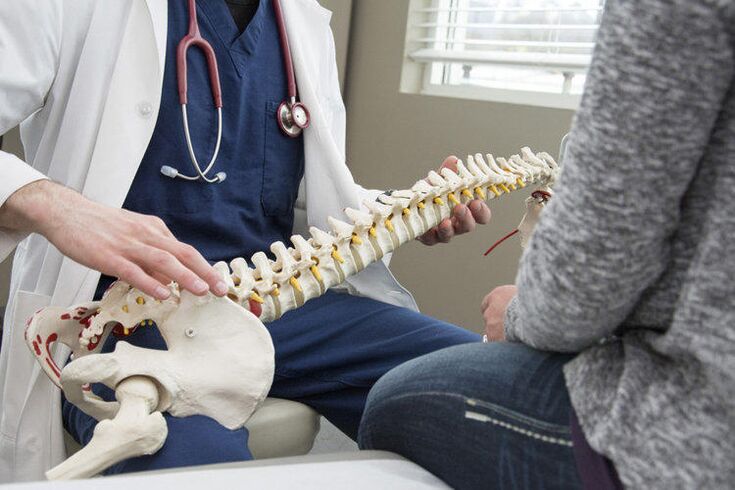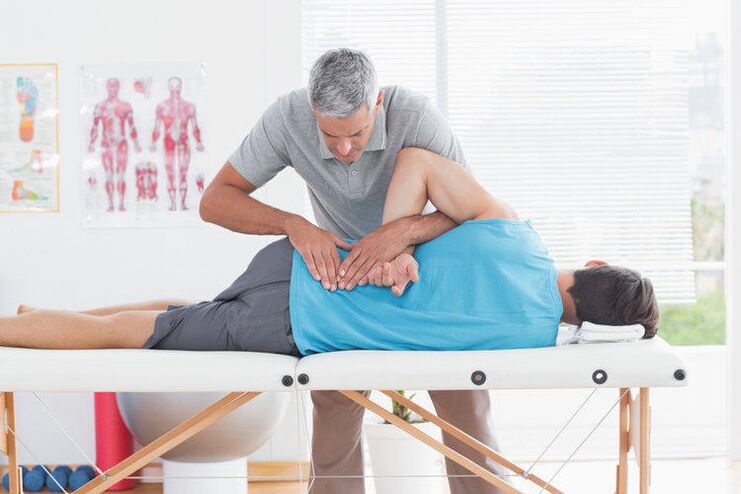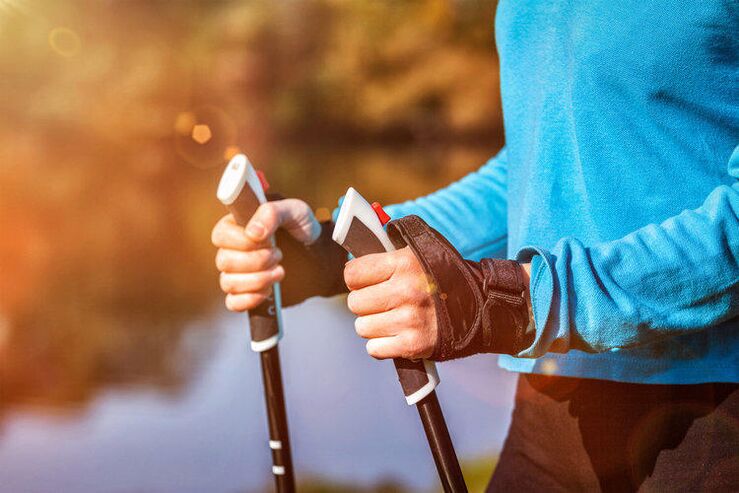Osteochondrosis is a disease in which degenerative-dystrophic changes are diagnosed in the tissues of the cartilage of spine, with the disorders of the structure and functionality of intervertebral disks. Depending on the localization of damaged tissues, osteochondrosis of cervical, thoracic and lumbal.

What is osteochondrosis?
Osteochondrosis is a spinal column disease in which degenerative and dystrophic lesions of interfaced discs appear. With the development of osteochondrose, degenerative-dystrophic lesions refer to the rooky tissue.
The main characteristic indicating the development of osteochondrose is the pain in the neck, back, the lower back, with the progression of "gives" the breasts, shoulder, with the susceptibility agility, as well as the dysfunction of the internal bodies, provocative, provocations. Volume. In the absence of timely therapy, osteochondrosis is developing into an incurable state.
Causes of osteochondrose
The main factor in the development of osteochondrose is an uneven load of the spine. The habit of carrying a bag on one shoulder or in one hand, an unsure call in a sitting position, a surnom on an excessively soft mattress, high pillow, carrying the anatomical irregular types of shoes are commonly the cause of improper cargo distribution.
Additional risk factors include hypodynamia, sitting lifestyle, back-out, lower extremity, straight legs, and other musculos-bone systems, as well as age degenerative processes in the supply browser in the blood supply.
In the etiology of osteochondrose, the following factors can play the role:
- Physical overvoltages of the body;
- neuro-emotional exhaustion;
- Metabolic disorders, poisoning, gastrointestinal tract diseases that prevent full assimilation of nutrients;
- Professional risks, especially, work on vibration platforms;
- Genetic predisposition;
- Violations of the position during active growth, scoliosis;
- Wearing unpleasant shoes (cramped, Pete);
- extended and / or regular dehydration;
- inferior nutrition, hypovitaminosis;
- Smoking;
- Pregnancy, especially multiple, combined with underdeveloped muscle-ligament apparatus (due to the relocation of the body center).
Stage stages of osteochondrose
Osteochondrosis in the dynamics of the disease passes four phases:

- Osteochondrosis of the first phase (degree) is characterized by the starting phase of pathology on the nucleus by the intervertebral disk. Due to excessive load, the process of dehydration (dehydration) core begins, which leads to a decrease in the disk height parameter and the occurrence of cracks in the fibrous ring. Symptoms at this stage are usually absent, less discomfort with extended stay in an unpleasant static loan, active movement, etc. ;
- In 2 stages, reducing the height of the disc leads to a reduction in distance between vertebral and curving of vertebrates and ligaments. This causes increased vertebral mobility with disks affected, which is dangerous to their moving or sliding. In the second phase of the disease, discomfort occurs, especially, especially with some types of load, movements, positions;
- Osteochondrosis 3 phases (degrees) is characterized by the formation of prolapse and protrusion of intervertebral discs, can be accompanied by the subluxis and / or the development of the arthrosis of interfere. With some kind of movement, patients feel stiffness, insufficient mobility, feeling of tingling, in the limbs can appear in the limbs. At this stage, osteochondrosis is obviously felt in the back, neck, lumbosacral department or coccyx, depending on the localization of affected disks;
- In 4 phases of osteochondrose, the body tries to adjust the consequences of the hypermobility of the vertebrae and adjust the impaired functionality of the spinal column. Osteofites, new bones, which are taking advantage of the fixation vrtofation are formed in the points of contact of vertebrae. However, in some cases osteophytes can cause violation of nerves, injure vertebrae. The fibrous ankylosis begins in the interfacebral disks and joints. In the absence of microtroums and breaches of nerve roots, the symptoms of the disease is coming to it.
Symptoms of osteochondrose
The main symptoms of osteochondrosis are a feeling of discomfort and / or pain in the neck, back. The severity of the sensation and the presence of additional symptoms depend on the phase of the disease. When examining the patient and the collection of anamnesis, the specialist implements the initial diagnosis, assuming the presence of osteochondrosis visually determined by the spine observed in the transverse or longitudinal plane of the vertebral column. The pathologies of the interveller discs of the uterus and lumbas are located much more often than degenerative and dystrophic changes in the field of sternum.
Signs of osteochondrose, feeling the patient, include a periodic or permanent feeling of tired fatigue, deleted or imposed, depending on the disease phase, pain. The pain can be localized in the neck, back, chest, carrier, complicate, fastening the upper limbs.
Clinical picture of osteochondrosis largely depends on the localization of pathology, the degree of process development, individual patient characteristics. The pathology of intervertebral discs, shifts, protrusions, hernia and increasing osteophytes lead to different consequences. Among the most common violations of normal blood circulation in tissues, abolish nerve endings, spinal channel dysfunction, edema, tissue fibrosis and structure.
Such consequences can follow many different symptoms, leading to the wrong diagnosis of the disease.
The most common and characteristic symptoms of osteochondorosis include the following:
- back pain, neck, lower back, shoulder belt, rib surface;
- Discomfort, stiffness of the movement of the body that occur in some body positions, inclination, turning, increased muscle tensions;
- a feeling of stiffness of the upper and lower extremities;
- Muscle and common discomfort, muscle cramps;
- Headaches, dizziness, increased fatigue;
- heartache;
- Breach of the sensitivity of the hand;
- Muscular hypotension.
Osteochondrose symptoms differ depending on the localization of pathology:
- With osteochondrose of cervix, the pain in the neck, arms, shoulder belt, radiating to the area of shoulders and shoulders are prevalent; Headache, dizziness, flickering "flies" or stain in front of the eyes, noise in the ears are noted;
- With the impairment of the thoracic spine, the pain is localized in chest, heart, the inner surface of the shoulders, the area of armpits, breathing discomfort was noticed, the disease is possible;
- Osteochondrosis Lurbosakracroceral spine is manifested in pain in the lower back with the radiation on their feet, top thighs or pelvic organs, sexual dysfunction is often joined.
Superficial symptoms - Heat-fatigue, pain - may indicate not only the presence of osteochondrose, but also adding other diseases or developing other pathological processes and disorders that are not connected to the distrophy of intervertebral disks. The diagnosis of osteochondrosis can only make a specialist, and self-help with such symptoms is unacceptable.
Osteochondrose diagnosis

To make a diagnosis, the methods of instrumental tests are used:
- X -ray testing of spine departments;
- myelography;
- Neurological survey of sensitivity, reflex.
Additional methods prescribed for differentiation and explanation diagnosis, the pathology phase include:
- Computer tomography of spine (CT);
- Nuclear-magnetic resonance imaging (jamr);
- Magnetic resonance imaging (MRI).
Directions of osteochondrose therapy
Treatment based on integrated approach and, depending on the phase, lasts 1 to 3 months of intensive care and 1 year support measures for the consolidation of the results and relapse prevention.
Osteochondrosis performs therapy for two directions depending on the degree of osteochondrosis and patient health. Conservative treatment of the disease consists of taking medicines, by performing a set of exercises. The surgical treatment in almost all situations cannot be the first choice and is prescribed in the absence of positive dynamics, promotion of diseases on the background of prolonged conservative therapy.
In addition to medical methods of therapy, it is necessary to follow general recommendations for osteochondrose: adhere to the diet, take the measures needed to rehabilitate.
Conservative osteochondrose treatment
Conservative therapy is aimed at stopping pain syndrome, normalize the functionality of the spinal column and the prevention of negative changes
Conservative osteochondrose treatment includes the following types of therapy:
- Drug therapy. Osteochondrose drugs are used to stop pain syndrome, inflammatory processes and the normalization of metabolic body processes. With the imposed pain syndrome, it is recommended to use drug blocks of nerve endings, which also contributes to reducing the severity of muscle tonic syndrome. The following types of blockages differ: blocking points of triggers, intraosic, aspects, paravertedbrals, epidural;
- Physiotherapy methods. Physiotherapy procedures help reduce pain, increase the effect of medications, are also used during the rehabilitation period. The most common use of ultrasonic waves, magnetic fields, low frequencies, laser beams, etc.
- Methods of physiotherapy exercises (exercise therapy) and kinesitherapy. The complex of spices with regular and correct execution contributes to the correction of position, the strengthening muscle corset, a ligamental apparatus, normalizes muscle function, reduces the compression of nerve fibers and helps prevent osteochondrose complications. Exercise methods and kinesespecies are focused on normalizing metabolic processes, renewing the full diet of interferebral disks, renewing the schedule of vertebrae and disks between them, uniform distribution of cargo in the musculoskeletal system;
- Massage. Hand massages techniques are used to improve blood supply in tissues, mitigating muscle cramps and clamps and generally improve blood circulation. Hydromassage as a direction of therapeutic activities In addition to these effects, contributes to the normalization of the nervous body system;
- Hand therapy. Manual therapy methods are selected individually. The effect on the musculos body helps to improve blood circulation, pick up the lymphs, improves the metabolism, promotes the mobility of the muscle-bone system, strengthens the immune system and serves as a means of preventing osteochondrose complications;
- The therapy towing the spine (lift) of the spine using special equipment. The purpose of manipulation is to increase the intervertal space in normal parameters, correction of breach of the structure of the spinal column.
Osteochondrose prevention

The causes of osteochondrosis are mainly linked in the absence of attention to the body requirements, malnutrition, excessive load on the body. To prevent the reinforcement of pathological changes in the spine and restraint the existing osteochondrose dynamics, it is recommended to adhere to the general principles of a healthy lifestyle:
- Exception Possibility of hypodynamia: moderate sports: filling, running, swimming, bicycle, skis, gymnastics, non-contact types of struggle, etc. ;
- During work or other forms of long stays in a static position, it is necessary to make a heating break every 45 minutes to return blood circulation. If necessary, sit down for a long time, you should choose the right chairs, chairs with your spine support, monitor the standards for hand position on the table, legs on the floor or special stand (even back, relaxed shoulders);
- For night sleep, it is necessary to choose an elastic, better orthopedic mattress with a flat surface, avoid high or too straight pillows;
- If necessary, raise and / or carry heavy objects to avoid Jerka, raising the seriousness from the position of the semi-hazusion, use special belts that support the lower back;
- Choice of orthopedic right shoes: with appropriate foot with width, without high heel and its timely replacement will help reduce the load on the spine, it is especially important for women in a period of a child. In summer, they do not ignore the possibility of walking barefoot on an uneven surface, this strengthens the feet muscles and relieves tension from the muscle system;
- Correct nutrition, drinking regime contributes to overall health and help maintain metabolism normally;
- With a tendency to increased emotionality, anxiety with a muscle spasmodic reaction to stress, it is worth studying relaxation methods.















































